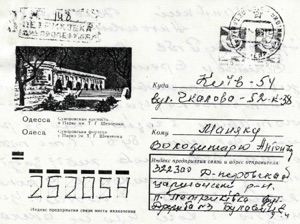












Full Name in Ukrainian: Єремій Михайлович Булавін
Full Name in English: Yeremii Bulavin
Data of Birth: Circa 1923-1924
Place of Birth: Petrykivka
Raion: Petrykivka raion (currently Dnipro raion)
Oblast: Dnipropetrovsk oblast
Country: Ukraine
Copy of original: Yes
Envelope: Yes
Number of pages: 4
Keywords: Ukraine--History--Famine, 1932-1933--Personal narratives; Famines--Ukraine--History--Sources; Famine victims; Holodomor; family mortality; Голодомор; child; search brigades; burial brigades; requisitioning; activists; perpetrators; mortality; family; childhood trauma
Notes: Abridged letter is published in 33: holod. Narodna Knyha-Memorial book, 1991, p. 178.



Yeremii Bulavin was nine at the time of the Holodomor. He describes events that took place in Petrykivka, Petrykivka raion, Dnipropetrovsk oblast (currently Petrykivka, Dnipro raion, Dnipropetrovsk oblast).
Yeremii was the youngest in the family of 16. His entire family died except for his big brother who lived in the city and took him in. He describes members of the search brigade and burial brigade as equally merciless. The former took everything, including pickled and dried fruit and vegetables from Bulavin’s family. The latter wanted to kill him and take him to the compost dugout, which served as a mass grave for the famine victims. Luckily for Bulavin, his neighbor walked into the house and stopped the burial briagade from taking little Yeremii to the grave.
Bulavin names some of the activists-perpetrators whom he calls "bandits", "a gang", “inhumane” (neliudy), merciless, and devoid of conscience. He calls “liars” the apologists of the activists who were literally killing people during the Famine under the pretext that their victims were kulaks. Bulavin believes that all possible kulaks were purged by 1930.
Only five people survived the Famine in their family’s neighborhood or sotnia (a section of a settlement consisting of approximately 100 households). Entire families died out, and their family names disappeared.
Bulavin’s letter is written in semiliterate Ukrainian. It is at times rambling and hard to understand.
SYNOPSIS


The UCRDC depends on voluntary donations – both individual and institutional - for its financing.
It provides receipts for tax purposes.
-
‣Home



